Intense action; great bosses; sharp visual design and animation; lovely and meaty pre-rendered cinemas; orchestral soundtrack; twisty and insightful story
More linear than previous Metroid games; unmemorable soundtrack; first person view clunky and pace-breaking; mediocre voice acting
Like most of the main characters in the recently ended TV series Lost, bounty hunter Samus Aran has serious daddy issues. That shouldn’t be too much of a surprise since she was orphaned at a young age and raised by bird people. Yet we’ve never really heard how much she agonizes over this issue until Metroid: Other M, a daring new take on the Metroid video game series that promotes intense action and elaborate story sequences over the solitary exploration and interpretive storytelling the series was previously known for.
For some, this new window into Samus’ soul has been jarring and unwanted. Gamers have spent decades projecting a personality of their design on to “gaming’s first lady.” Roughly, she should be some amalgamation of the Alien movie series’ Ellen Ripley, the Ghost in the Shell series’ Major Motoko Kusanagi, and finished with a dash of Rosie the Riveter. Samus should have an emotional dimension but be driven much more by rational, strategic thinking, rapid reflexes, and major butt-kicking of all enemies — no matter the size.
In this Team Ninja and Nintendo co-developed title, however, she’s revealed to be much more emotionally complex. At times, Samus expresses doubt and paralyzing fear, and also slips into helpless uncertainty when around the man she has fashioned as her father figure, Galactic Federation Army commanding officer Adam Malkovich. Gamers will get to see Samus stunned, intimidated, petulant and even ready to cry (though not all at once; this isn’t Super Princess Peach). Few people expected this range of human emotion when staring at the expressionless green visor of Samus’ helmet over all these years. Whether you’re willing to accept that Samus has more in common with everyday people than an idealized superhero will determine your appreciation of her newest evolution.
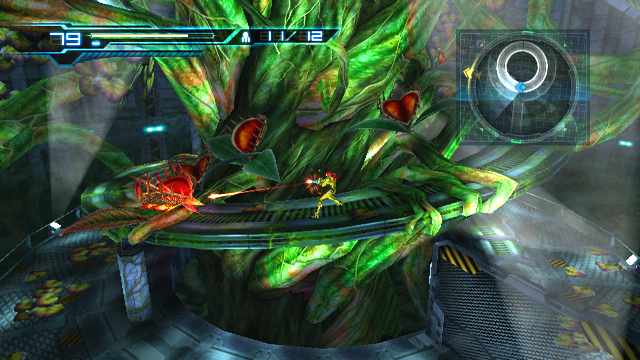
Perhaps addressing an action game’s story before its gameplay seems backward, but so much angst has been made about Samus’ mood swings that the intriguing story and the solid gameplay has been nearly pushed aside. For what it’s worth, Samus’ characterization may not be everyone’s cup of tea, but Team Ninja exceeds expectations in creating a fun story with several plot twists, deep thoughts on the manifestation of individual and group psychology, and believable reasons for Samus’ unexpected emotional outbursts. Also, Nintendo’s Yoshio Sakamoto, who was co-creator of the original Metroid and directed every Nintendo-internally-developed Metroid title since (to include the revered Super Metroid), oversaw and directed Other M.
Neither Team Ninja nor Nintendo “pulled a fast one” in this evolution of Samus by involving an outsider who hasn’t had an idea on what makes Samus tick. Conversely, the Metroid games have perhaps given us too many years to come up with our own idealized Samus Aran for this psychology to be revealed today, but given an open mind, Other M‘s story provides entertainment and appeal once you get over her requiring Adam’s “authorization” to use her suit’s myriad power-ups.
The setup: Months (or maybe even a year) after wrapping up her planet- and Mother Brain-destroying mission in Super Metroid, and every particle of the last, exploded baby Metroid is scoured from her suit, a distress beacon blares within Samus’ gunship while she’s touring the galaxy. Samus instinctively sets course for the signal, which is coming from the Bottle Ship, a scientific research complex shaped like, yes, a bottle. This fantastic structure is capable of simulating wildly variant planet terrains within its interior, Star Trek Holodeck-style, ensuring that while Samus will trek through many eerie, ravaged rooms and hallways that bear a striking resemblance to Dead Space‘s USG Ishimura, there will also be time spent in rain forests, lava-filled volcanic areas and, of course, arctic, wintry zones.
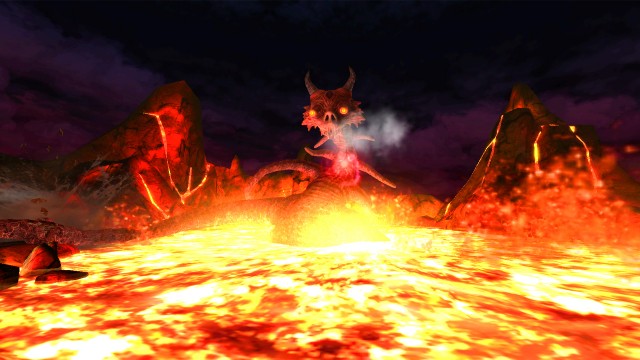
All the while, Samus will be working in tandem with a group of Galactic Federation Army troops who have also arrived to investigate the distress signal. Since Samus is a freelance bounty hunter, the troops, former peers of Samus’ when she was in the Army, have jurisdiction. Thus, the man in charge, Malkovich, only allows Samus to assist their investigation for her extra abilities, provided she agrees to follow their orders as well as deactivate a majority of her suit’s powers and weapons (there are too many unknown variables — survivors, animals — to allow Samus to blow everything to kingdom come right off the bat). Malkovich, Samus’ aforementioned father figure and former superior, will also remotely authorize her suit’s abilities to be reactivated on an as-needed basis, as determined by him, even if that means making several trips through deathly heat first.
As with Sakomoto’s earlier GBA titles Metroid Fusion and Metroid Zero Mission, Other M is very directed and linear, but to an even greater degree than its side-scrolling predecessors. Other M is unlikely to have any speed run competitions as the “sequence breaking” and free-roaming nature of previous Metroid games is not built in here: Malkovich has clear assignments of where Samus needs to go, and she must follow them in order. The gamer can return to the ship’s environment in an epilogue side quest, fully powered up and able to explore most of the ship undirected. But if you’re hoping for a “Metroidvania” experience, you’ll have to put that on hold for the 10 hours it takes to get through the game’s main story, collecting roughly 50 percent of all the missile and energy power-ups along the way.
Considerably more forward-thinking than giving a backstory and voice to Samus is Other M‘s gameplay design, which is a hybrid of a 2.5-D side-scrolling platformer (like Yoshi’s Story or the Wii Klonoa remake) and a first-person shooter. Given that the game is controlled exclusively with the Wii remote, there’s no analog or camera control. That said, the mechanics of Samus’ actions are simplified but still dramatic, flashy and exciting. When holding the remote sideways, the directional pad moves Samus horizontally, vertically and “into” halls and rooms just like a regular side-scrolling platform game on a fixed path. The camera constantly swivels to the perfect angle, and walls are made transparent as needed, showcasing a true mastery of camera design by Team Ninja. Some areas provide full movement in any direction instead of a set path, and while jumping is free-form, firing Samus’ arm cannon is not. Her blaster auto-aims at the nearest enemy and can be readjusted by pivoting Samus or simply jumping closer to whatever’s intended to be shot.
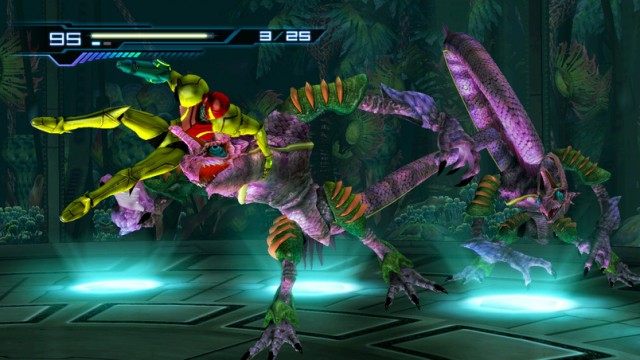
A notable upgrade while in the side scrolling mode is Samus’ “sense move” dodge, perhaps inspired by how much counterattacks pay off in Team Ninja’s Dead or Alive series. By tapping any direction just before being hit by an attack, Samus will flip out of harm’s way and reorient her gun’s sights on her assailant. If the firing button is held down during this dodge, Samus will emerge from her evasive maneuver not only aiming at her attacker but with a fully charged-up power shot waiting to be released. This move– not bomb jumping or grapple hooking– is the real lynchpin of all of Other M‘s action and is essential when swarmed by enemies and tackling the numerous, tricky bosses from the game’s start to finish.
The other gameplay twist occurs when the remote is pointed at the screen. The camera swoops down for an “in the helmet,” first-person view through Samus’ visor, and from this perspective the gamer can freely look around the entire environment– to include those invisible fourth walls that are normally never seen in 2D side-scrollers. The drawback of 360-degree viewing is she is stuck standing in place. Also of note is only from this perspective can Samus fire her trademark missiles or grappling beam. While you’ll get the hang of it, flipping the remote from sideways to pointing can still be a bit clunky and frustrating during intense boss battles that require the maneuver to be executed in milliseconds.
Furthermore, the point-for-first-person gameplay never feels like something you’d want to have in every Metroid game going forward. At best, it’s a compromise between the original side-scrolling Metroids and the first-person Prime series. At worst, it’s an obnoxious, momentum-halting gimmick when the game forces you to use the perspective in an awful hidden object/”Where’s Waldo?” minigame during certain points of the story. Expect to waste many minutes hunting for random, unclear “clues” when you just want to get back to running, dodging and shooting.
Hunting for Samus’ incremental power-ups (life bar extensions, increased missile capacity, faster beam charging) however, is more fun than expected, especially considering they’re plainly plotted on the game’s map once you clear a room of enemies. That may seem to make things too easy, but even if you can clearly see the power up in a cage or compartment, getting to it is often tricky, sometimes necessitating an entry point from several rooms away. After completing the game’s main story and jumping back into the Bottle Ship, the map highlights all overlooked power-ups and provides a sector-by-sector completion percentage for overachievers, and Metroid purists may enjoy this segment most, since Samus is fully powered up and no longer nagged or locked down by third-party directives.
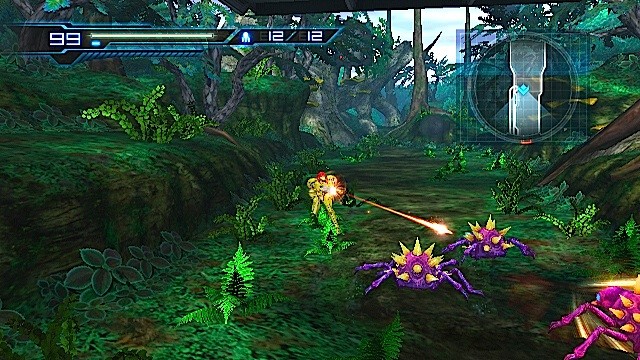
Wrapping up the game is an excellent audio and visual presentation. It may not be as elaborate as the Prime series’ high points, but loading is minimal and the game’s environments, if a bit thematically perfunctory, are nicely rendered and populated with pleasant refreshes of classic Metroid enemies alongside a few new beasts. The seamlessly integrated cinemas are extremely well done and often hard to tell apart from the in-game engine. They’re only occasionally dulled only with some “zany” camera swishing and poor lip synching.
Samus and the other female characters are, unsurprisingly for Team Ninja, lovingly designed and rendered in a way that’s not as hypersexualized as the women of Dead or Alive and Ninja Gaiden. The males, on the other hand, seem to have received half the thought and attention. When putty-faced Adam seems to have the same face as one of his grunts, and the original concept art (unlocked after finishing the game) shows far more personality and differentiation in the male characters, there’s clearly a bit of ball-dropping on the development team’s behalf. If the game’s audience is going to have this small group of characters forced upon them, all the character models should be treated with the same attention to detail.
Voice acting is also hit or miss. By the game’s end you’ll likely have gone numb to a Samus voice that seems miscast as too young-sounding, too theatrically inexperienced or some combination thereof: she’s unlikely what you’d expect or want to hear. The other actors do a solid job, however, and their performances are only distracted by the aforementioned shoddy lip synching.
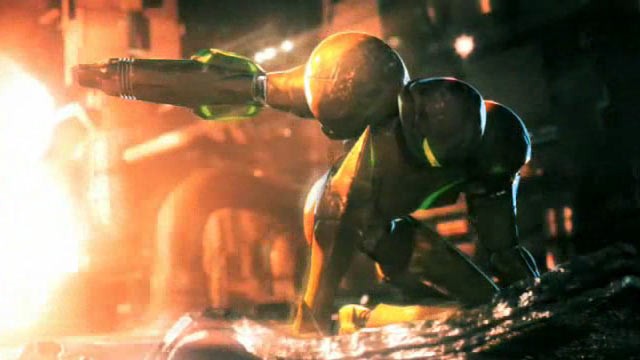
Last but not least is the soundtrack, which as Andrew covered last week, was handed off to an anime soundtrack composer. His work is definitely serviceable, but it seems he only begrudgingly includes classic Metroid themes, and rarely at that. Expect to hear plenty of generic action and atmospheric music that maintains the series tradition of occasional absence in favor of ambient sound effects. During boss battles, though, you’ll be pushed to the edge of your seat: these moments certainly feature the best music, even if you won’t remember it later.
Regardless the shortcomings, Nintendo definitely deserves praise for yet again hiring not one but two orchestras to play the game’s soundtrack start to end– hearing real strings and percussion, occasionally augmented by sci-fi synthesizer, adds a lushness to the soundtrack that Metroid has long deserved. Now all we need is a Zelda game with a full orchestral soundtrack (surely Skyward Sword) and the symphonic triumvirate will be complete.
Looking back at how many editorials and pleads have been made for Link to talk in his adventures, the reaction to Samus’ first fully self-narrated game makes the likelihood of Link ever talking near impossible. Thanks to Other M, we finally know so much more about Samus’ psychology and weaknesses, yet to the over-reacting chagrin of incensed fan boys and armchair feminists.
“OMG, Samus has emotions and daddy issues! Sexist!”
Whatever. Then there are complaints that the game’s too linear and directed, which is a bit more understandable coming from series traditionalists. Yet if you put your assumptions to the side and enjoy the game for what it is, you’ll find a very exciting and at times challenging action game, complemented by a heaping dose of cinematic flair that Nintendo has never been known for, and an intriguing, twisty story. Other M may not be what everyone expected or wanted, but it’s still a great game in its own right, certain to be debated, critiqued and celebrated for years to come.
Nintendojo was provided a copy of this game for review by a third party, though that does not affect our recommendation. For every review, Nintendojo uses a standard criteria.




 ShareThis
ShareThis






The content of Other M -definitely- was not expected for me in many ways, which I think I discussed with you previously, but I thought it bore repeating. Great review, though! Personally, I thought the character of Samus was a bit of a let-down, but I mean, I’m sure it was going to happen regardless. As you said, the lady’s been around for a long time without talking, so … well, yeah. We’ve had a lot of time to project our own personalities on her.
Pretty much my only response to the emotions/daddy issues that Samus has is– well, look at the way she’s been traveling so far. She’s always been alone. It’s pretty clear that that’s going to have some repercussions.
Really interesting review, I feel like I really understand what’s good and not so good about Metroid: Other M. Loads of reviews have just spun off on tangents of how the game’s a crushing let down. Always enjoyable reading, I’m sure you can guess.
I also think it’s a bite lame how people are being harsh on the cinematic quality of the game. Sure, yes it’s a product but it’s a Nintendo game. This isn’t Nintendo speciality, they’re good at so many things but they’ve never went into this department before. I don’t see what the point was of crying out for a game like this for ages and then slating their first attempt at something bold for Nintendo.
I need to get Other M. As soon as I find some time and dosh.
It’s fun, but I did fin the linear game-play a little annoying (not as annoying as the First Person switching, though)
I really missed the Item tone. When you got a new item, even a missile, it was exciting. Now it is just “Buddha buh”!
I’m glad the classical- Metroid music was still around, though. The Metroid Soundtrack always had that scary, slow, ambient music!
I felt The only people that had life were Anthony and Samus, and even then, it felt pretty plastic; but that’s one fault of the 3D age. And what IS the deal with Adam only talking to Samus when she dies?
All in all, I thought the game was fun. I spent at least 16 hours walking in circles, thinking something was more complex than it was. Yes, I spent 30+ hours on it.
I’m still waiting for a long 3D/2D version sidescroller, in the style of Super Metroid, to be made.